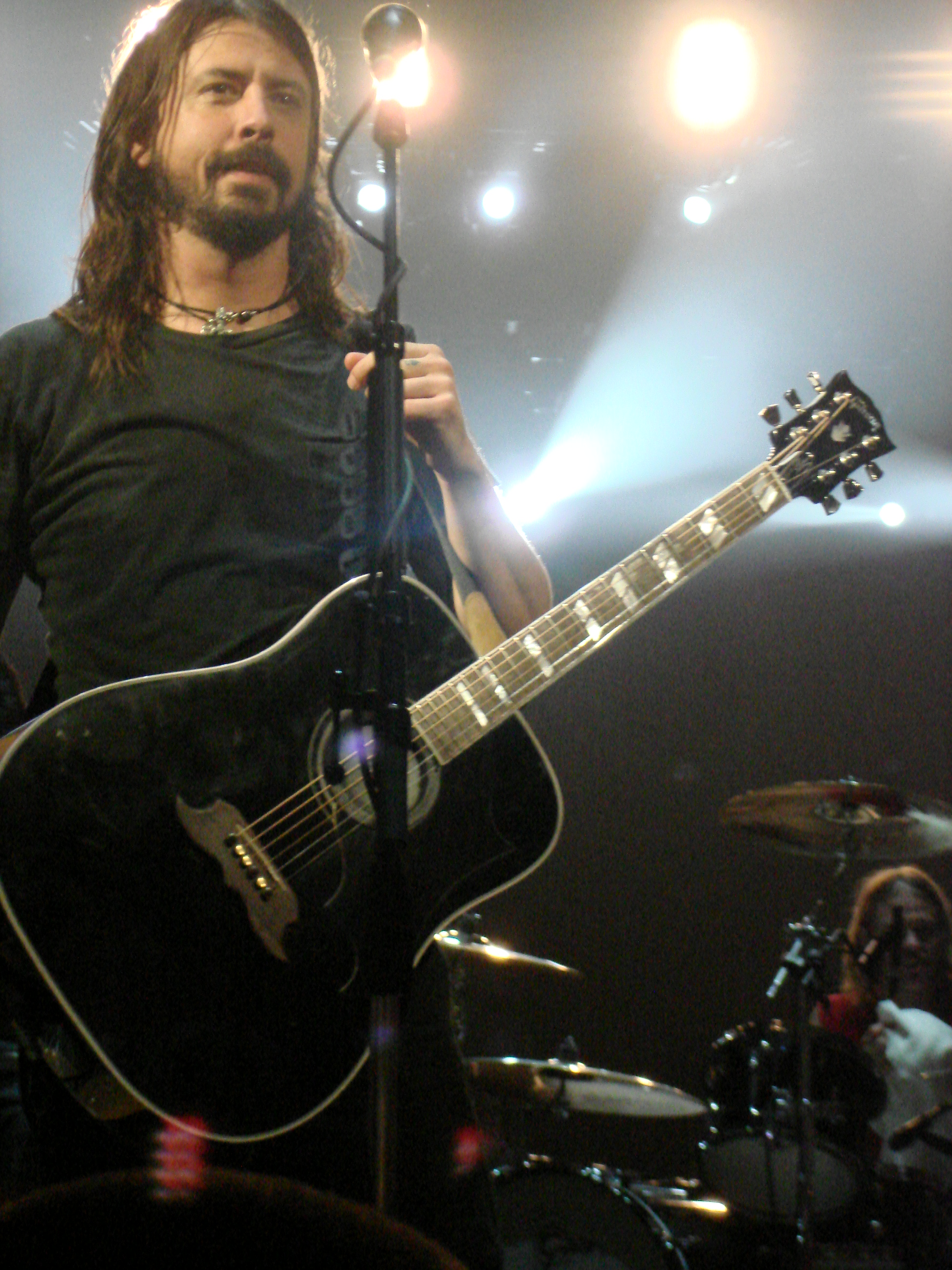
Dave Grohl, an iconic figure in the music world, is widely recognized not only for his formidable guitar and vocal talents but also for his groundbreaking work as a drummer. His journey began in the late 1980s, primarily with the influential grunge band Nirvana. Grohl’s drumming style, characterized by power, precision, and emotional depth, quickly made him a sought-after musician in various genres.
Indeed, if you’ve ever wanted to play drums like Dave Grohl, or simply understand what makes him such a unique drummer, then delving into his gear choices and stylistic evolution is paramount. Since he made the move from drum throne to frontman, Grohl has undoubtedly become one of the most accomplished and authentic rock stars in modern history. Yet, his legacy behind the kit, particularly with Nirvana, remains a constant in conversations about the greatest rock drummers of all time.
This article embarks on an in-depth exploration of the drumming arsenal and techniques that have defined Grohl’s remarkable career. From the thunderous beats of the grunge era to the rock-solid grooves of the Foo Fighters and beyond, we uncover the specific instruments and approaches that have allowed him to leave an indelible mark on rock music. Let’s peel back the layers of a percussive legend and discover the tools that helped forge his unique sound.
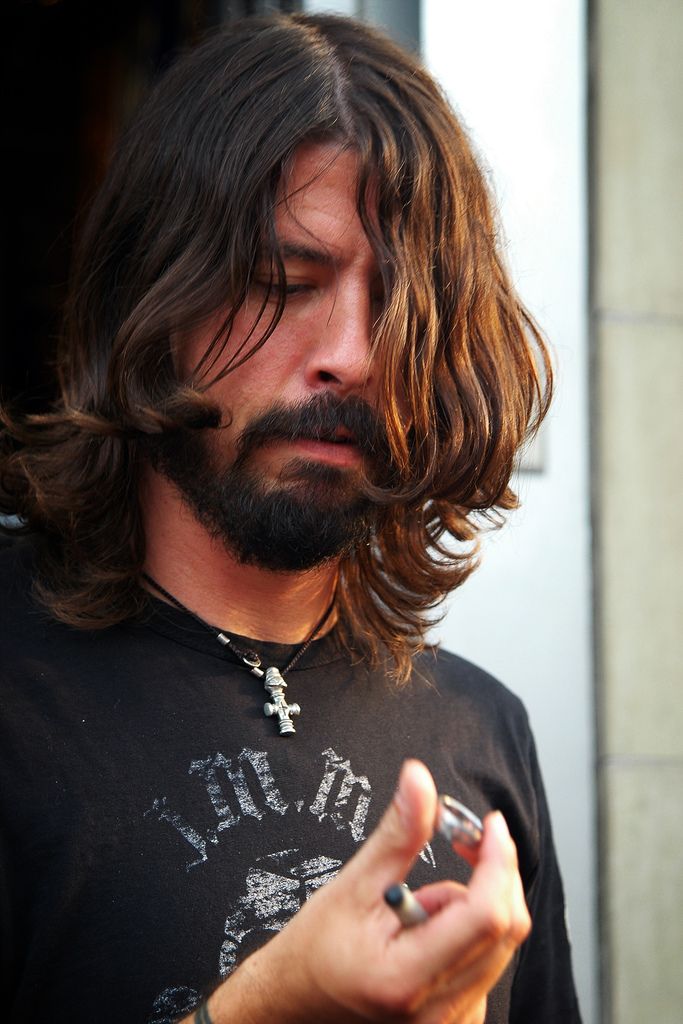
1. **Tama Granstar: The Grunge Genesis Kit**Dave Grohl’s drumming became synonymous with Nirvana’s explosive sound during his tenure with the influential grunge band. His primary drum kit during this era was the Tama Granstar, a model revered for its unwavering durability and powerful projection. The very essence of grunge, raw and unbridled, found its rhythmic voice through the Granstar’s capabilities.
The Granstar’s maple shells were instrumental in delivering a warm yet undeniably punchy tone, perfectly suited for the raw energy that characterized Nirvana’s music. This kit was the backbone for some of the band’s most iconic tracks, including the epoch-making “Smells Like Teen Spirit” and the electrifying “Lithium.” It provided the deep, resonant foundation upon which Kurt Cobain’s riffs and vocals soared.
Grohl’s typical setup with the Tama Granstar included a 22-inch kick drum, ensuring a deep and solid low-end that drove the band’s sound forward. He utilized a 14-inch snare drum, often a Tama model, designed to cut through the dense mixes of grunge with its sharp attack. Complementing these were 10-inch, 12-inch, and 16-inch tom-tom configurations, offering a versatile range of tones for his dynamic fills.
Notably, this specific Tama Granstar kit, with its distinctive Silky Yellow finish, served Grohl from 1990 to 1991. It met a dramatic end, famously demolished at the Cabaret Metro in Chicago on October 12, 1991. Such was the intensity of Grohl’s performances, often pushing his gear to its absolute limits, a testament to his thunderous playing style.
Drum technicians Barrett Jones and Mike Dalke detailed the precise components of this era, confirming the 8”x14” Birch Snare and the massive 16”x24” Bass Drum, alongside 14”x15” Rack Tom and 16”x18” Floor Tom specifications for this particular Granstar. This configuration, with its notably large drums, truly laid the groundwork for Grohl’s signature sound.
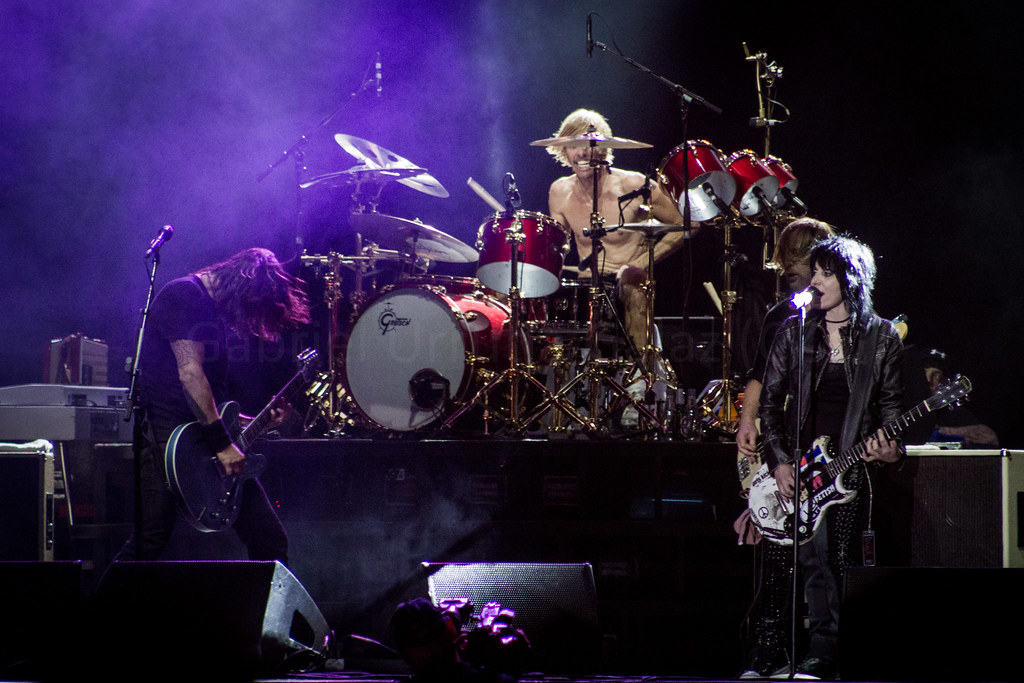
2. **Tama Artstar II: Evolving the Grunge Sound**While the Granstar was a workhorse, Grohl was also known to integrate the Tama Artstar II series into his Nirvana setup on occasion. This particular series featured a distinct blend of birch and mahogany, a combination that yielded a remarkably rich sound. It provided a sonic depth that beautifully complemented the band’s heavy guitar riffs, offering an alternative texture to the raw Granstar.
The Artstar II, often appearing in a striking Piano Black finish as his chief set-up for the In Utero tour, continued Grohl’s preference for large, impactful drums. This kit, like the Granstar, was meticulously chosen to withstand the sheer force of his playing while delivering a powerful, resonant sound. It further solidified his commitment to instruments that could translate his aggressive style into a sonic punch.
Technicians confirmed that the Artstar II setup largely mirrored his Granstar configurations, featuring the same foundational components. This included the substantial 8”x14” Birch Snare, a 14”x15” Rack Tom, a 16”x18” Floor Tom, and the booming 16”x24” Bass Drum. This consistency in size across different Tama models underscores Grohl’s unwavering vision for a massive, unyielding drum sound.
The presence of the Artstar II in his arsenal highlights a subtle evolution even within the seemingly monolithic sound of Nirvana. It demonstrated a nuanced approach to tone, allowing for variations that could support different sonic landscapes within the band’s repertoire. This attention to detail, even amidst the raw power, speaks volumes about Grohl’s innate musicality.
Beyond these primary kits, the context mentions a Tama Granstar II in a Fire Storm Red finish, utilized for the remainder of the US Nevermind tour, and a Tama Rockstar-Pro also seeing significant road use during the In Utero tour. This indicates a practical and tour-demanding approach to his equipment, where durability and consistent powerful projection were paramount.
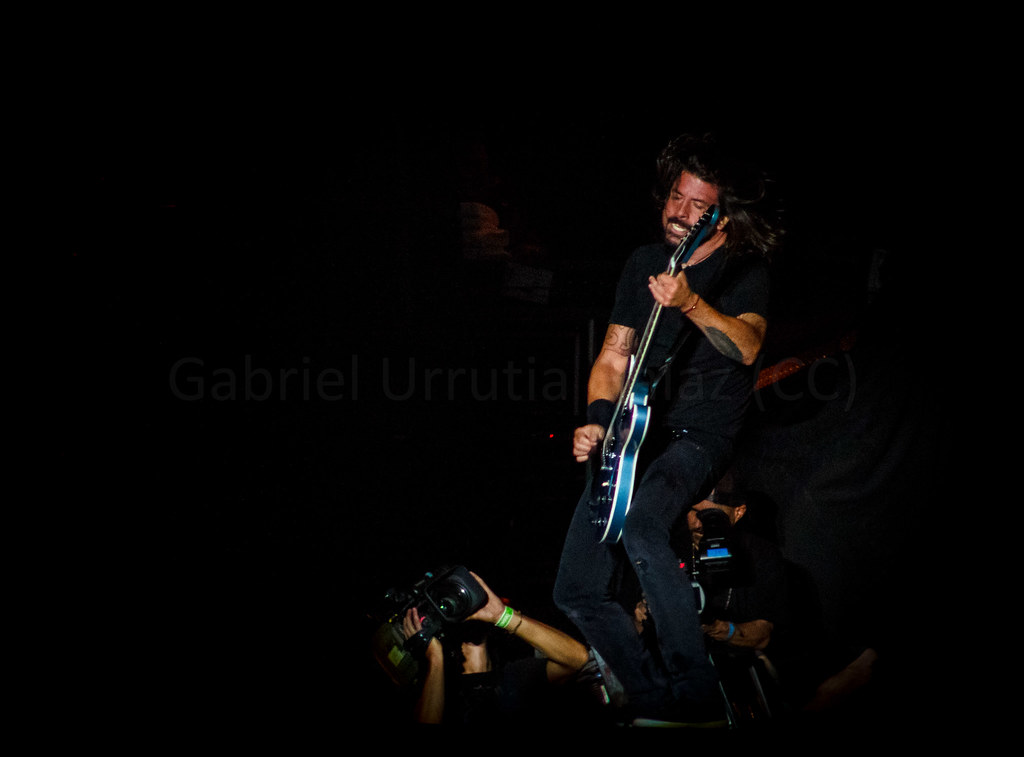
3. **DW Collector’s Series: The Foo Fighters’ Polished Powerhouse**As Dave Grohl transitioned into his role as frontman for the Foo Fighters, his musical direction evolved towards a more polished sound, a shift distinctly mirrored in his choice of drum kits. During this era, he primarily embraced the DW Collector’s Series, a line renowned for its exceptional craftsmanship and superior tonal quality. These kits became integral to the Foo Fighters’ diverse sonic exploration.
Crafted from select woods, DW Collector’s Series kits offered Grohl a vast palette of sound possibilities. This allowed the band to navigate a wide spectrum of styles, from hard-hitting rock anthems to more intricate and melodic compositions. The adaptability of these kits was perfectly suited for the Foo Fighters’ dynamic range, accommodating their varied musical excursions.
The key components of Grohl’s DW setup during this period typically included 22-inch kick drums, delivering a consistently solid low-end punch that anchored the Foo Fighters’ sound. His snare drums were often 14-inch DW models, specifically chosen for their crisp attack and impressive versatility, allowing them to cut through the mix with clarity and presence.
His tom-tom configuration, featuring 10-inch, 12-inch, and 16-inch drums, was meticulously tailored to his dynamic playing style. This setup enabled him to execute intricate fills and melodic passages, which became a hallmark of his drumming in tracks like “Everlong” and “The Pretender.” Grohl’s ability to blend complex rhythms with powerful choruses found its perfect complement in the DW Collector’s Series.
Beyond their sonic excellence, Grohl’s DW Collector’s Series kits were often customized to reflect his personal style and artistic vision. This included unique paint jobs, such as the Pelham Blue finish later seen on his Them Crooked Vultures kit, echoing his Gibson DG-335 Trini Lopez guitar. This meticulous attention to detail ensured that his equipment was not just a tool, but an extension of his musical identity.
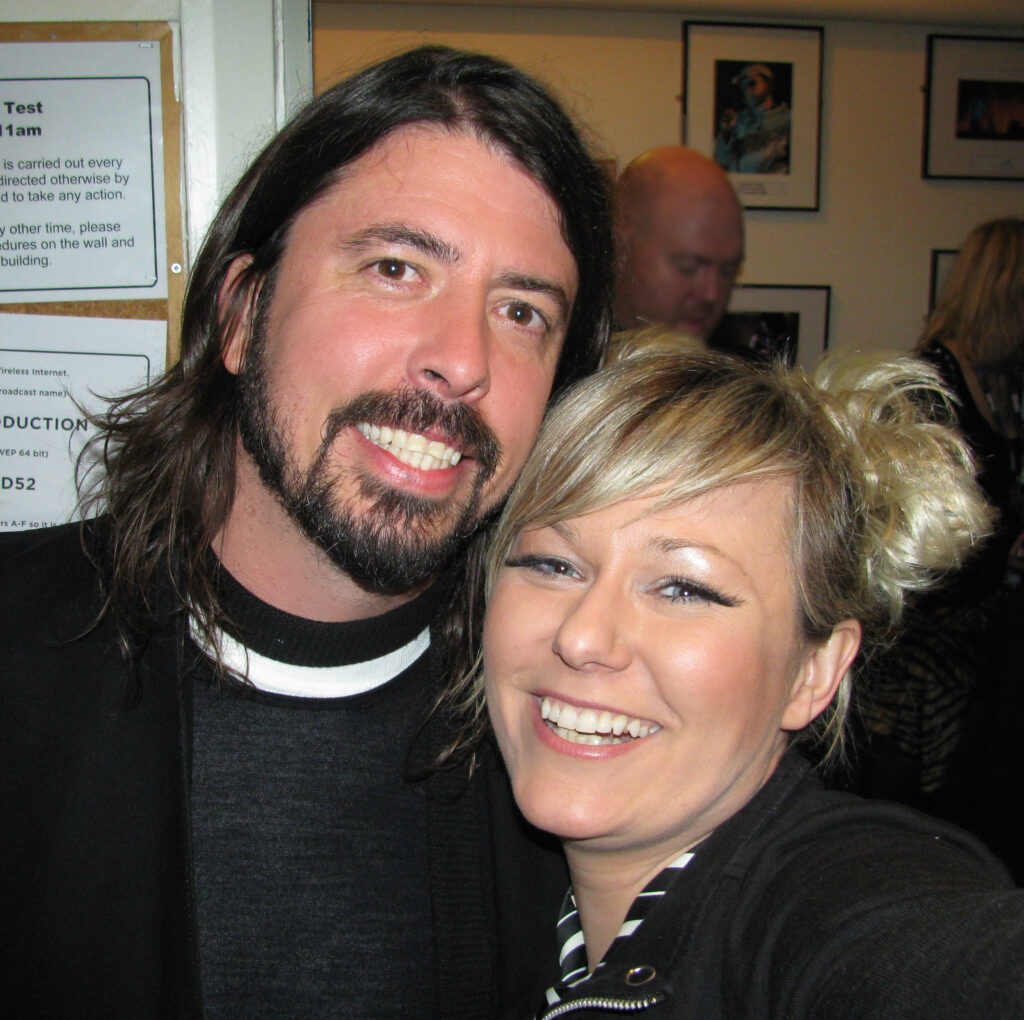
4. **Them Crooked Vultures Custom Kit: Supergroup Versatility**In another significant chapter of his career, Dave Grohl joined Them Crooked Vultures, a supergroup that brought together members of Queens of the Stone Age and Led Zeppelin. For this project, which embraced a heavier and more versatile sound, Grohl required a custom-built kit designed to meet the unique demands of his collaborators. This showcased his adaptability and the importance of tailored gear.
Grohl’s drum tech, Gersh, provided rare insights into this custom setup, revealing that for the Vultures’ tours, he approached Scott Donnell at DW. The objective was to synthesize everything they had achieved in the studio into one cohesive live kit. The decision landed on DW’s Jazz Series shells, which Gersh described as “old technology, new design,” praising them as his favorite drums being made at the time.
These Jazz Series shells featured a specific 7-ply construction: two plies of North American hard rock maple on the inner, three plies of gumwood in the middle to enhance low-end frequencies, and a two-ply maple outer. This intricate design resulted in a warm, open sound, imbued with real character, further refined by the softer ‘Butter Edges’ that contributed to their nuanced resonance.
The initial configuration for the Vultures’ kit was ambitious, including a massive 24-inch bass drum, 12-inch, 13-inch, and 14-inch tom-toms, alongside 16-inch and 18-inch floor toms. A particularly notable inclusion was a 20-inch gong drum, which became an integral part of the kit, having been used by Dave on the track ‘Warsaw Or The First Breath You Take After You Give Up’.
For the final tour setup, Gersh made a strategic adjustment, opting for the 13-inch tom-tom instead of the 14-inch. This choice was driven by the desire for a fundamentally higher note to complement the existing large drums, allowing Dave to set up sections with that first rack more effectively. The kit was finished in a distinctive Pelham Blue, matching Grohl’s Gibson DG-335 Trini Lopez guitar, a thoughtful gesture that Dave was immensely excited about.
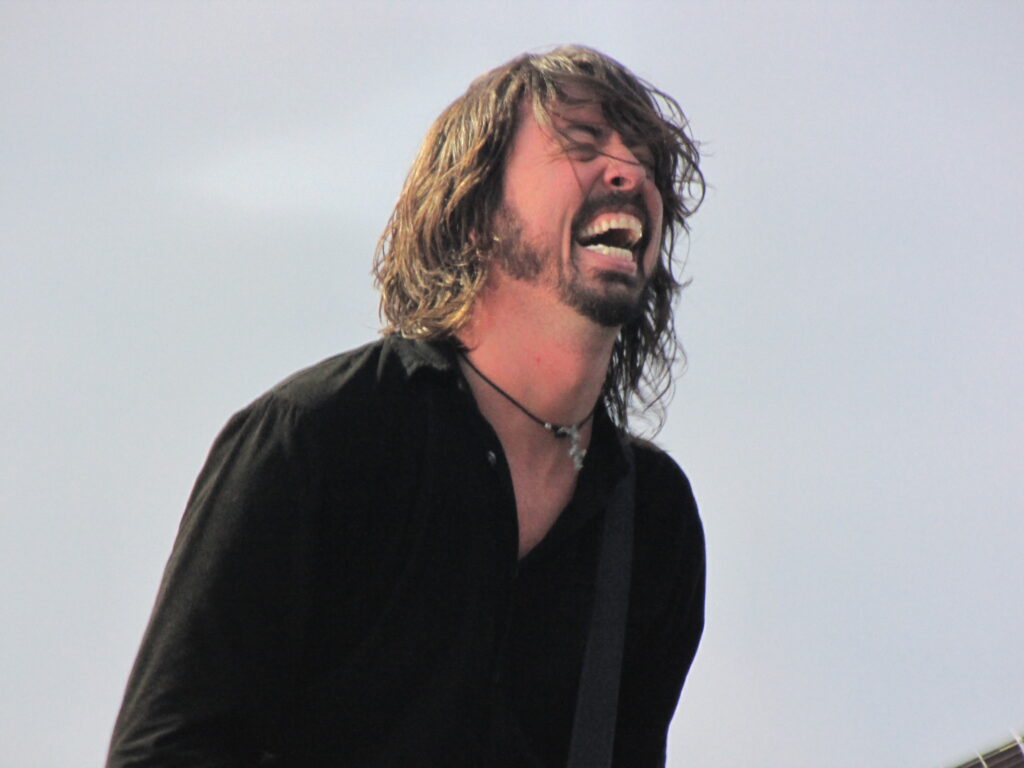
5. **Grohl’s Signature Kick Drums: The Driving Force**Throughout his illustrious career, Dave Grohl’s choice of kick drums has remained remarkably consistent in its core preference. He consistently gravitates toward 22-inch models, a size he finds strikes an optimal balance between depth and attack. This characteristic is absolutely crucial for effectively delivering the powerful rhythms essential to both grunge and rock genres.
The punchy sound emanating from Grohl’s kick drum contributes significantly to the overall drive of his performances. It provides a solid, unwavering foundation for his intensely dynamic drumming style, propelling the music forward with an undeniable force. This steady, impactful presence from the low-end is a hallmark of his sonic identity, whether in the raw energy of Nirvana or the anthemic scope of the Foo Fighters.
During his formative years with Nirvana, Grohl, much like his inspiration John Bonham, famously played with a huge 16-inch by 24-inch booming bass drum. This colossal instrument was instrumental in bringing an astounding heaviness to the band’s sound, creating a percussive bedrock that felt almost seismic. It was a clear statement of intent, announcing the arrival of a truly powerful drummer.
When engaging with projects like Them Crooked Vultures, Grohl would sometimes amplify this low-end impact even further. For those heavier sounds, he opted for a hybrid setup that included dual 22-inch models. This configuration allowed for an enhanced low-end, providing an even more formidable rhythmic presence suitable for the supergroup’s hard-rocking inclinations.
Beyond mere size, Grohl demonstrates an acute understanding of how to utilize the kick drum for dramatic effect. He masterfully employs it as a tension-builder, subtly adding more bass drums in the latter half of pre-choruses, as brilliantly exemplified in “Smells Like Teen Spirit.” This technique expertly drives the riff towards the eventual release of the chorus, a deliberate and expertly executed maneuver that elevates the song’s intensity.
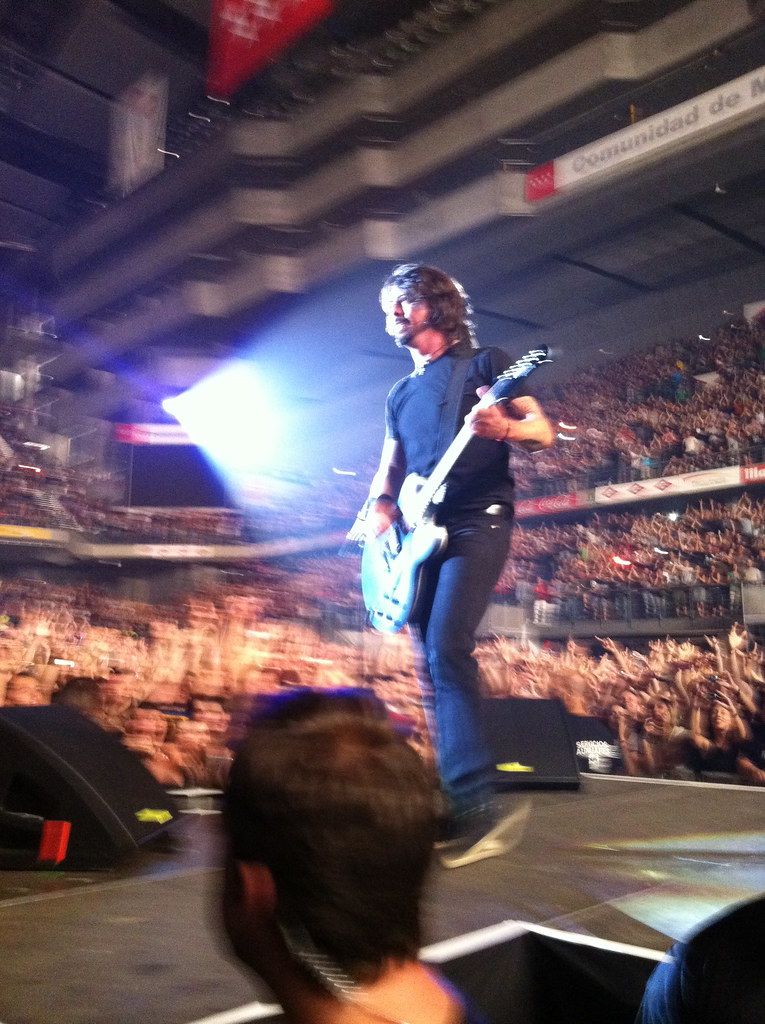
6. **Grohl’s Essential Snare Drums: The Cutting Edge**The snare drum stands as a vital component in Dave Grohl’s kit, providing the characteristic sharp crack that effortlessly cuts through even the densest musical mixes. This instrument is crucial for delivering the primary backbeat, and Grohl’s meticulous selection process ensures it always carries maximum impact and clarity, defining the rhythmic pulse of his performances.
Over the years, Grohl has utilized various snare drum models, often favoring the robust offerings from both Tama and DW. A particular favorite has been the DW 14-inch snare, renowned for its remarkable sensitivity and its ability to seamlessly handle both soft, nuanced passages and aggressive, powerful playing styles. This versatility allows him to adapt his snare sound to the demands of any song or genre.
To achieve specific tones for various songs and projects, Grohl often customizes his sound by utilizing different snare drum heads. This adds a crucial layer of personalization and sonic fine-tuning to his setup, ensuring that each crack and ghost note resonates exactly as he intends, further embedding his unique signature into the music.
During his Nirvana era, the 8-inch by 14-inch Birch Snare was a consistent feature, whether it was a Tama Superstar, Artwood, or one from the Granstar II series. These deep, impactful snares were chosen for their ability to project forcefully and withstand the relentless battering of Grohl’s powerful strokes, becoming a foundational element of the grunge sound.
For collaborations such as Them Crooked Vultures, Grohl opted for custom snare models specifically designed to deliver sharp attacks, perfectly suited for the supergroup’s hard rock inclinations. This willingness to tailor his gear for different projects highlights his dedication to achieving the ideal sound for every musical context, proving that even a powerful drummer like Grohl understands the nuances of tone. He also skillfully flips from snare to cross-stick in tracks like ‘Heart-shaped Box,’ demonstrating a dynamic interplay that adds iconic tension.
Furthermore, the snare drum plays a significant role in Grohl’s tension-building techniques. The intro to ‘Breed,’ for instance, famously employs a single-stroke snare roll, complete with pounding bass drum, to create an aggressive and forthright build-up. This effective use of the snare drum showcases its pivotal role beyond just providing a backbeat.
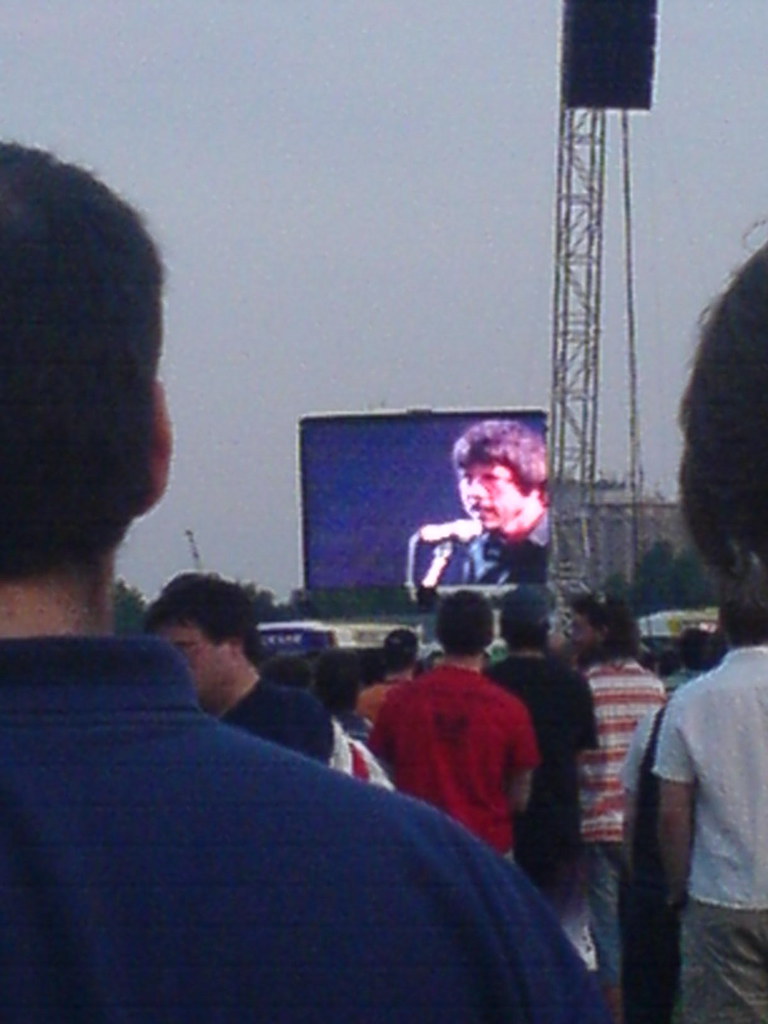
7. **Grohl’s Definitive Cymbal Choices: The Bright and Cutting Edge**Beyond the thundering drums, Dave Grohl’s percussive landscape is undeniably shaped by his meticulous cymbal choices, a critical aspect that provides the bright, cutting tones essential for his powerful drumming style. He has predominantly relied on Zildjian cymbals throughout his career, a brand revered for its clarity and projection, perfectly complementing his aggressive yet nuanced approach. These cymbals aren’t merely accessories; they are vital sonic extensions, punctuating his rhythms with emphatic crashes and driving grooves with shimmering rides.
His typical Nirvana-era setup, as meticulously documented by his drum technicians, was a masterclass in impactful cymbal selection. It comprised Zildjian A Series Medium 18-inch and 20-inch crashes, a commanding 22-inch ride, and crucially, 15-inch hi-hats. This array of larger cymbals was no accident; it allowed Grohl to produce a fuller, deeper sound that could effectively fill the expansive percussive space in Nirvana’s sparse, three-piece rock setting, ensuring his contributions were always prominent.
The choice of 15-inch Zildjian A Custom Hi-Hats is particularly noteworthy, echoing the influence of drumming titan John Bonham. This specific size provides a wider, more authoritative “chick” and a fuller wash, perfectly suited for Grohl’s powerful strokes and his high-mounted cymbals. Barrett Jones, Grohl’s drum tech, vividly recalled that Dave “used only Zildjian As,” noting the solitary exception of a colossal 28-inch Paiste ride/crash with Scream, which “he broke… within a year,” a testament to the sheer force he exerts.
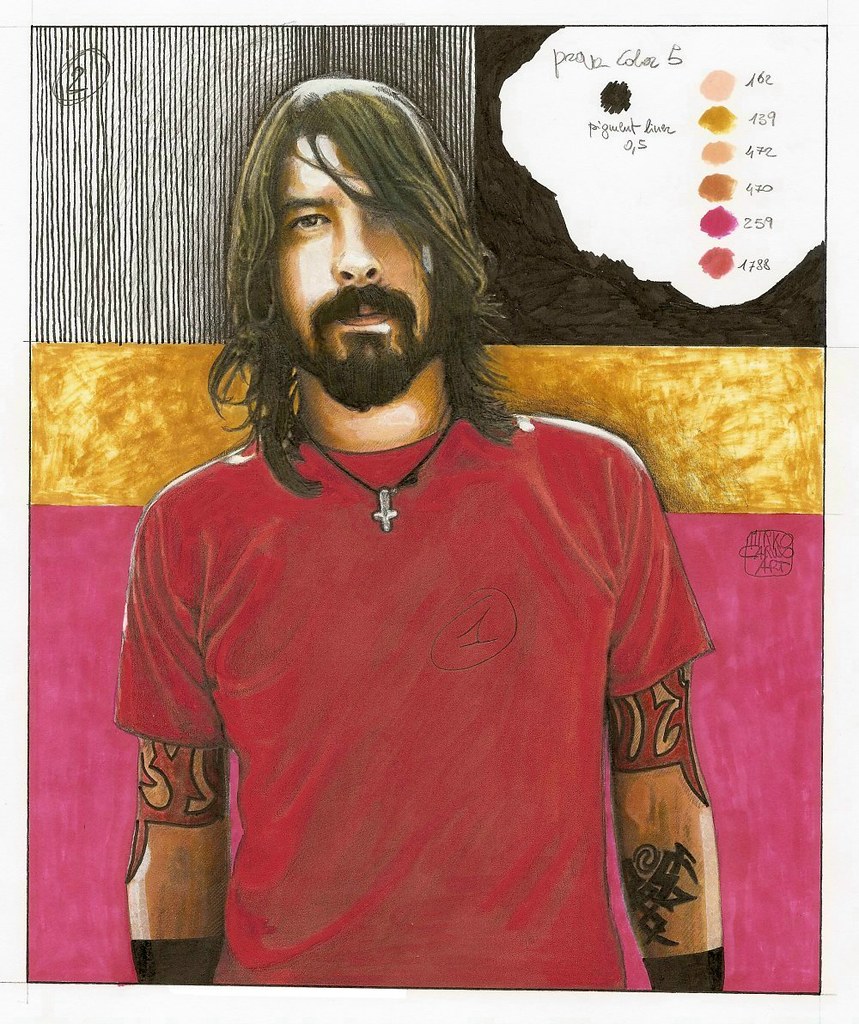
8. **Drumhead Customization: The Battle for Durability and Tone**For a drummer of Dave Grohl’s intensity, drumheads are a critical interface for durability and tone, constantly battling the relentless assault of his sticks. His choices underscore a fundamental need for resilience, alongside a precise understanding of how different skins contribute to his signature sound, ensuring consistent power night after night.
Nirvana drum tech Barrett Jones offered invaluable insight into Grohl’s specific preferences. For the snare drum, the top head was an Aquarian Hi-Energy, chosen because “it was the only brand that wouldn’t break.” This speaks volumes about the sheer force Grohl applied, demanding unparalleled durability. The bottom head, designed for resonance, was a Remo Ambassador Resonant Snare-Side, completing a combination engineered for endurance and a crisp, cutting attack.
His tom-toms were outfitted with Remo Pinstripes on top, known for their thicker construction and durability. Beneath these, Clear Remo Ambassadors served as resonant heads, allowing the toms to sing with a clear, sustained tone. Jones vividly recounted that these tom heads were “changed before every show,” a stark indicator of the brutal battering they endured. For the bass drum, Grohl opted for a Remo Clear Powerstroke on the batter side for focused attack, while the resonant side was typically an Ebony Ambassador with a 6-inch hole off-center, optimizing air movement and a controlled low-end thump.
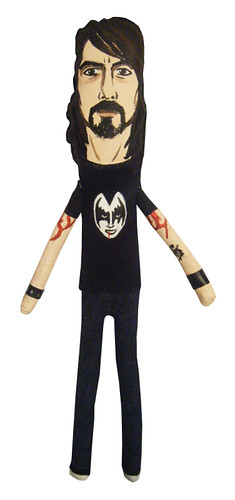
9. **Hardware: Built to Withstand the Onslaught**The hardware supporting Dave Grohl’s monumental drumming is a testament to engineering resilience, battling the sheer power of his playing. Given the legendary ferocity of his attack, his stands, pedals, and mounts are crucial fortifications against an almost superhuman rhythmic force, constantly pushed to their absolute limits.
Most of Grohl’s hardware during his Nirvana tenure comprised the robust Tama Titan Series. A notable exception was a special Sonor hi-hat stand, which, as drum tech Barrett Jones explained, was “the only kind that was tall enough for him” for his high-mounted hi-hats. The crew even carried “two with us on tour in tour in case one got messed up,” acknowledging the extreme stress on every component.
Mike Dalke, another technician, offers vivid anecdotes regarding the relentless punishment inflicted on cymbal stands. He recalled stands “gaffer taped and sand-bagged… so firmly that the force from Dave’s sticks would go from the cymbal directly to the spindle… and the spindles would only last about four shows.” It was as if “the cymbals would cut right through the metal,” leading to dramatic instances where “Dave, on two occasions, hit the crash so hard that the top of the stand cracked off and the cymbal came flying into his lap.” Such incidents highlight the reality of Grohl’s playing.
The bass drum pedal, a crucial rhythmic link, also faced a relentless barrage. Dalke noted “Pretty much every piece of the [DW 5000 Turbo] pedal broke at different stages.” Chains and fastening nuts snapped regularly, necessitating three pedals on tour. This consistent mechanical failure, driven by Grohl’s colossal footwork, led DW to significantly “increase the durability of these pedals,” illustrating Grohl’s influence on drum manufacturing advancements.
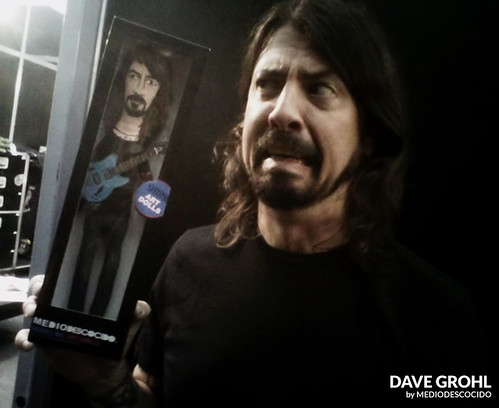
10. **Playing Techniques: Thunderous Attack, The Grohl Signature**When one thinks of Dave Grohl’s drumming, “thunderous” immediately comes to mind. It’s the cornerstone of his unique sound and has defined his presence throughout his illustrious career. While he possesses a remarkable sense of dynamics, as even Kurt Cobain noted his struggle to “bring down the volume” for MTV Unplugged, it is this sheer, unadulterated power that has etched his name into rock drumming legend. Yet, as he demonstrated with brushes on that very Unplugged set, his thunder is a controlled, deeply musical force.
Grohl’s hard-hitting style emerged from an unconventional, almost primal training ground. Without drum lessons as a kid, he famously “learned to play by ‘listening to Rush records and playing on pillows with big thick marching band sticks’.” Lacking natural rebound or sound reference, this method inadvertently forged one of the hardest-hitting drummers in rock history, compensating with brute force. His early hardcore punk days for Scream further honed this relentless attack.
Upon joining Nirvana, Grohl brilliantly fused his hardcore punk technique with classic rock ‘n’ roll grooves, drawing inspiration from legends like John Bonham. This potent combination made him the most globally iconic rock drummer of the 1990s. Foo Fighters drummer Taylor Hawkins succinctly captured this essence: “You have to be an athlete to play these drum parts – I play really hard, and that’s the key… you’ve got to beat the out of the drums.”
Indeed, “beat the out of the drums” was Grohl’s modus operandi, famously using 5B and 2B sticks the wrong way around to generate an even more powerful stroke. This commitment to maximal impact is vividly showcased in tracks like “Everlong,” where his thunderous drumming, a go-to for aspiring drummers, drives the song with an irresistible, primal energy. It’s a style that is aggressive yet undeniably melodic.
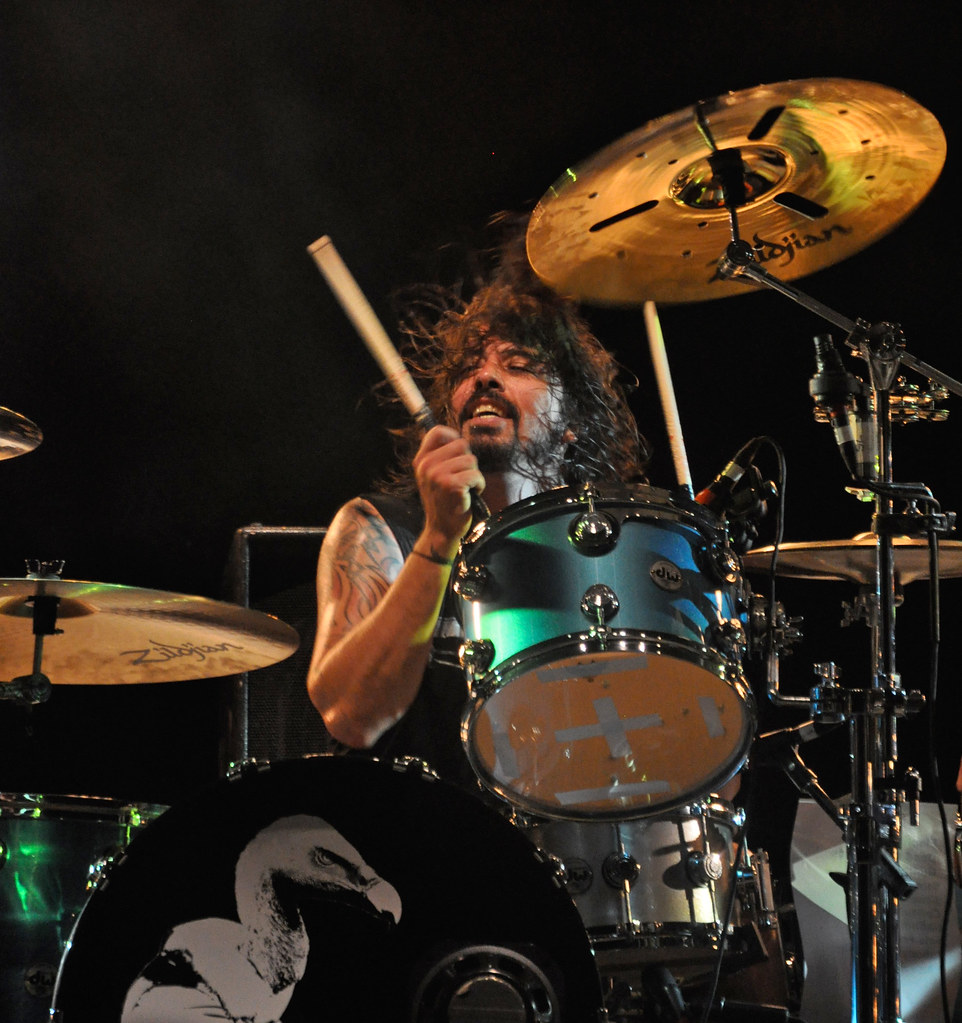
11. **Playing Techniques: Mastering Space and Dynamics, The Subtle Power**While Dave Grohl is celebrated for his thunderous attack, an under-appreciated yet crucial element of his drumming genius lies in his masterful ability to “sit back and leave space.” This nuanced approach to dynamics adds profound depth and atmosphere, demonstrating that true power isn’t just about hitting hard, but knowing precisely when to hold back and allow the music to breathe.
Within Nirvana’s iconic catalog, some of their biggest hits feature verses where Grohl consciously takes a back seat, employing lighter instrumentation for a subtle yet driving backbeat. Prime examples like “Lithium” and “Come As You Are” showcase this beautifully. Here, Grohl often plays delicate 8th notes lightly on the ride cymbal, combined with judicious bass and snare or rim work. This minimalist approach provides ample room for Kurt Cobain’s vocals and guitar riffs to soar, cultivating a far more atmospheric and emotive feel.
As Grohl transitioned with the Foo Fighters, the band’s generally lighter musical style presented even more natural opportunities for leaving space. Tracks such as “February Stars” and “For All The Cows” demonstrate how a laid-back feel in the verses can powerfully aid the eventual kick into heavier, more expansive choruses. By creating this dynamic contrast, Grohl effectively emphasizes the emotional trajectory of the songs, highlighting the washier cymbal choices and full-throttle impact.
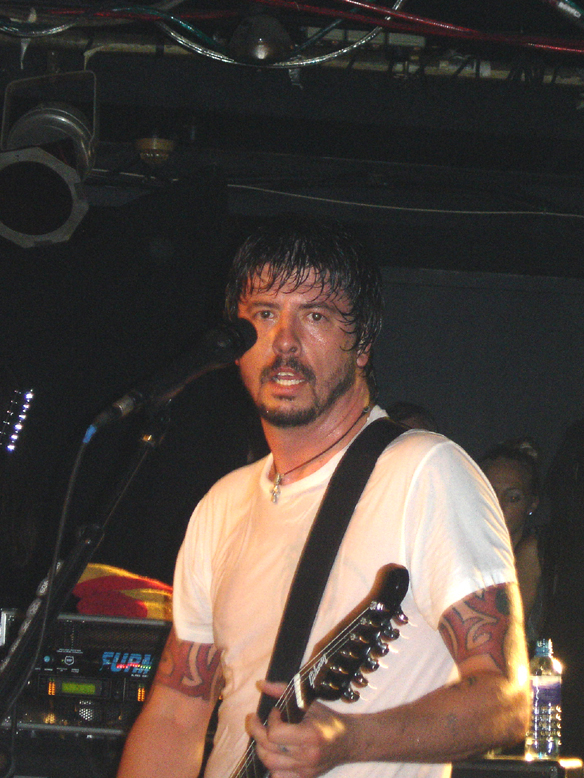
12. **Playing Techniques: Building Tension and Personalizing Fills, The Architect of Excitement**Dave Grohl’s drumming is a powerful narrative force, expertly building tension and infusing personalized flair into established techniques to maximize emotional impact. He acts as an architect of excitement, employing specific rhythmic tools to propel listeners towards explosive musical releases, each moment stamped with his unmistakable signature. This thoughtful manipulation of rhythm and dynamics is central to his lasting influence.
One hallmark tension-builder is the potent single-stroke snare roll paired with a pounding bass drum. Nirvana’s “Breed” intro stands as a prime example, a relentless, aggressive build-up frequently used to open live shows. The same intense technique dramatically kicks off “Territorial Pissings,” signaling unbridled energy from the outset.
Grohl also masterfully uses the bass drum for subtle tension. In “Smells Like Teen Spirit,” he strategically “subtly adds more bass drums in the second half of the pre-chorus.” This deliberate maneuver inexorably drives the iconic riff towards the cathartic chorus release. Similarly, in the Foo Fighters’ “This Is a Call” outro, he doubles the bass drum pattern in the second half, creating an urgent, relentless kick that elevates the part before the drums abruptly cut out.
Beyond tension, Grohl personalizes common drumming tropes, making his fills instantly recognizable. His single-stroke rolls, while standard, carry a unique touch. For “This is a Call,” pre-chorus fills vary: in the first two, he “chooses to leave out a single note which creates a kind of falling momentum,” contrasted with a “straight” final one for variation. Queens of the Stone Age’s “No One Knows” offers another masterclass; its epic bridge sees Grohl laying into the bass line with a single stroke snare roll, adding expertly placed crashes, toms, and space, culminating in a magnificent 32nd note fill crescendo.
Flams, too, receive this personalized treatment. Beyond their iconic presence in “My Hero” and “In Bloom,” repetitive flam fills powerfully drive Queens Of The Stone Age’s “Go With The Flow.” The opening beat from Nirvana’s “Scentless Apprentice” is equally striking, where precise single flam placement transforms a powerful rock beat into an instantly recognizable, elemental riff—a rhythmic fingerprint uniquely Dave Grohl’s.
**The Undeniable Legacy: A Drummer’s Enduring Blueprint**
Dave Grohl’s journey, from Nirvana’s raw power to the Foo Fighters’ dynamic force, and through countless collaborations, has solidified him as a titan of rock drumming. His meticulously chosen gear—from resilient Tama and customizable DW kits to Zildjian cymbals and battle-tested hardware—forms an arsenal perfectly tuned to his unique vision. Yet, it is his singular playing style—the thunderous attack, the masterful use of space, and the ingenious tension-building techniques, all infused with a deeply personal touch—that truly defines his genius. Grohl hasn’t just played drums; he’s redefined the instrument’s role in modern rock, offering a blueprint that marries raw power with profound musicality, ensuring his thunderous legacy reverberates through generations.



